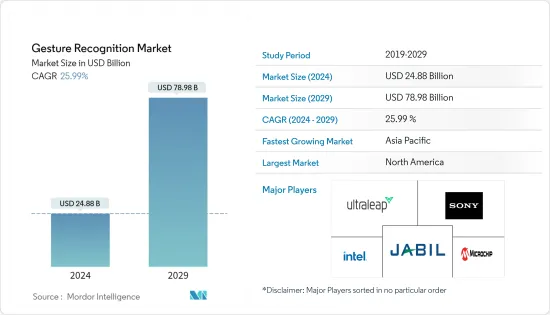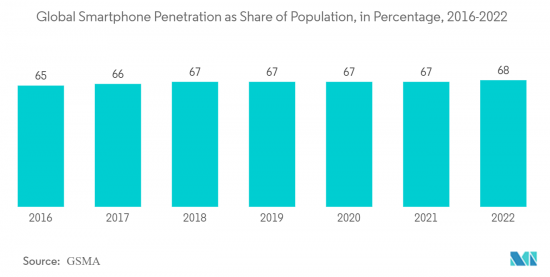 |
市場調查報告書
商品編碼
1403086
手勢姿態辨識:市場佔有率分析、產業趨勢/統計、成長預測,2024-2029Gesture Recognition - Market Share Analysis, Industry Trends & Statistics, Growth Forecasts 2024 - 2029 |
||||||
※ 本網頁內容可能與最新版本有所差異。詳細情況請與我們聯繫。
手勢姿態辨識市場規模預計到 2024 年為 248.8 億美元,預計到 2029 年將達到 789.8 億美元,在預測期內(2024-2029 年)複合年成長率為 25.99%。

主要亮點
- 人工智慧 (AI) 的進步正在催生基於手勢姿態辨識的設備。此外,還分析了手勢姿態辨識技術領域的最新技術進步,以及最終用戶產業的日益普及,以推動未來幾年的市場發展。
- 由於支援手勢的電子設備在各個行業(例如切換電影片道或廣播電台)的接受度不斷提高,手勢姿態辨識技術擴大在人機互動中得到應用。手勢姿態辨識在各個領域的使用正在增加。
- 該領域的最新發展之一是使用手勢姿態辨識的人機互動。使用手勢姿態辨識來控制電腦應用程式也得到了發展。
- 隨著技術的不斷發展,研究市場中的公司正在製造具有新功能和創新功能的產品。Omron Corporation開發了手勢姿態辨識技術,透過參考相機拍攝的影像,同時辨識人的手和手指的位置、形狀和運動。
- 此外,手勢姿態辨識技術已引起消費者和原始設備製造商 (OEM) 的高度關注,以提高使用者使用各種電子產品時的便利性。世界各地的製造商都致力於創新,為各種消費性電子產品添加手勢姿態辨識功能,使其更安全、更可靠、更方便。此外,對良好使用者體驗、易用性以及各領域數位化的需求日益成長,主導了非接觸式手勢姿態辨識的需求。
- 手勢姿態辨識應用系統由幾個主要的硬體和軟體組件組成,所有這些組件必須緊密整合才能提供有吸引力的使用者體驗。此外,特殊演算法解釋處理後的資料並將運動轉換為電腦可以理解的可執行命令。然後,應用程式將這些可執行命令與必須自然且引人入勝的用戶回饋整合。演算法和應用程式通常在處理、儲存和其他資源有限的嵌入式系統中實現,這增加了解決方案的整體複雜性。
- 此外,人工智慧和機器學習等先進技術在手勢姿態辨識生態系統中的整合正在進一步擴大研究市場。人工智慧和機器學習技術的普及將透過提供廣泛的應用程式來實現手勢識別,這些應用程式豐富了醫療保健服務、智慧導航、消費性電子產品、擴增實境遊戲、家庭自動化、即時視訊串流、虛擬購物手勢姿態辨識領域的功能,正在引起人們的注意。
- 疫情期間,手勢姿態辨識技術在對抗COVID-19大流行中的作用變得越來越重要。採用非接觸式手勢姿態辨識技術已成為維護公共衛生與安全的關鍵要素。採用非接觸式手勢姿態辨識技術已成為維護公共衛生與安全的關鍵要素。此外,在後 COVID-19 世界中,非接觸式手勢姿態辨識可能會在許多商業和醫療保健領域普及。此外,疫情後的技術進步正在進一步擴大所涵蓋的市場。
手勢姿態辨識市場趨勢
基於觸控的手勢姿態辨識領域預計將佔據主要市場佔有率
- 基於觸控的手勢姿態辨識由單點觸控螢幕和多點觸控螢幕組成,廣泛應用於消費性電子產品。許多裝置(例如智慧型手機)都提供一種基於觸控的功能。例如,您可以一鍵存取智慧型手機的功能表列。由於具有上述基本功能的筆記型電腦和智慧型手機的高普及,基於觸控的手勢姿態辨識領域佔據了很大一部分市場。
- 此外,隨著越來越多的消費性電子產品(例如智慧型手機和筆記型電腦)採用並配備基於觸控的手勢姿態辨識,這些消費性電子產品的普及預計將對市場成長產生積極影響。隨著企業將重點轉向亞太地區,尤其是印度,推出價格更低且具有觸控手勢姿態辨識功能的智慧型手機,智慧型手機預計將在未來幾年持續成長。例如,根據 GSMA資料,預計 2022 年全球智慧型手機普及將達到 68%。
- 基於多點觸控的手勢姿態辨識用於智慧型手機功能,例如放大、縮小和三指螢幕截圖。交換桌面和存取功能表等 Windows 10 功能內建於筆記型電腦的觸控板中。目前,由於具有上述基本功能的筆記型電腦和智慧型手機的市場普及較高,基於觸控的手勢姿態辨識領域在調查市場中佔據主導地位。預計該部門在預測期內將保持不變。
- 智慧型手機製造商現在推出具有觸控手勢姿態辨識功能的智慧型手機,例如雙擊睡眠/喚醒。筆記型電腦製造商還推出了具有觸控手勢姿態辨識的低成本產品,從而提高了該技術的可用性。
- 此外,基於觸控的手勢姿態辨識設備在工業應用中是首選。該行業的工作環境需要堅固耐用的設備,能夠在惡劣條件下運行,包括戴著手套和塗油的手使用。產品還需要經過特定行業安全和標準的認證,這使其成為實施該行業使用的產品的優質解決方案。

北美預計將佔據很大佔有率
- 北美是手勢姿態辨識技術採用的市場先驅和主要創新者。 Jabil Inc.、Leap Motion Inc. 和 GestureTek Inc. 等供應商的總公司在該地區。與世界其他地區相比,該地區的研發投資不斷增加,預計該地區技術的採用將進一步推動市場成長。
- 此外,豪華汽車對基於手勢的使用者介面的需求不斷成長,也增加了該地區汽車行業對手勢姿態辨識的需求。消費者對先進車輛功能的偏好不斷增加,以及OEM在研發方面的大量投資可能會推動產品的普及。
- 在需求方面,由於更換週期的下降和主要消費群體消費能力的恢復,美國預計將保持其作為消費性電子設備主要市場之一的地位。預計在預測期內,手勢姿態辨識技術將在消費性電子產品中廣泛採用。對攜帶式電子產品和無線通訊的需求不斷成長預計將推動當前的區域市場。美國是世界上消費電子產品的主要消費者之一。美國也被稱為技術先進國家,使其成為多家電子製造商的目標。
- 此外,該地區在零售業中佔有重要地位。手勢姿態辨識技術的採用預計也將在零售業中成長,進一步推動該地區的市場成長。 Reasor 是一家位於奧克拉荷馬州的連鎖雜貨店,它安裝了一個互動式顯示螢幕,將公司的標誌和訊息投射到地板上。客戶可以在該顯示器上行走,並透過簡單的手勢和身體動作與其進行互動。
手勢姿態辨識行業概況
手勢姿態辨識市場的競爭較為溫和,少數大型企業具有較大影響力。這些產業巨頭目前佔據主導市場佔有率,並積極尋求擴大海外市場影響力的策略。為了實現這一目標,他們組成了策略聯盟,以擴大市場佔有率並提高盈利。
其他福利:
- Excel 格式的市場預測 (ME) 表
- 3 個月分析師支持
目錄
第1章簡介
- 研究假設和市場定義
- 調查範圍
第2章調查方法
第3章執行摘要
第4章市場動態
- 市場概況
- 產業吸引力-波特五力分析
- 供應商的議價能力
- 買方議價能力
- 新進入者的威脅
- 替代品的威脅
- 競爭公司之間敵對關係的強度
- 價值鏈分析
- COVID-19 市場影響評估
第5章市場動態
- 市場促進因素
- 技術進步和對高效 HMI 經濟高效功能的需求
- 人工智慧和機器學習技術的進步以及感測器價格的下降
- 終端用戶產業擴大使用支援手勢姿態辨識的設備
- 市場抑制因素
- 使用手勢姿態辨識技術涉及的演算法、數學和其他複雜性
- 由於「始終開啟」的使用者介面,手勢感應器導致電池消費量較高
第6章市場區隔
- 依技術
- 基於觸摸的手勢姿態辨識
- 非接觸式手勢姿態辨識
- 按最終用戶產業
- 航太/國防
- 車
- 消費性電子產品
- 遊戲
- 衛生保健
- 其他
- 地區
- 北美洲
- 美國
- 加拿大
- 歐洲
- 英國
- 德國
- 法國
- 其他歐洲國家
- 亞太地區
- 中國
- 日本
- 印度
- 其他亞太地區
- 其他地區
- 拉丁美洲
- 中東/非洲
- 北美洲
第7章競爭形勢
- 公司簡介
- Intel Corporation
- Jabil Inc.
- Ultraleap
- Microchip Technology Inc.
- Sony Corporation
- Elliptic Laboratories AS
- Google LLC
- GestureTek Inc.
- Fibaro Group SA
- Eyesight Technologies Ltd
第8章投資分析
第9章 市場機會及未來趨勢

The Gesture Recognition Market size is estimated at USD 24.88 billion in 2024, and is expected to reach USD 78.98 billion by 2029, growing at a CAGR of 25.99% during the forecast period (2024-2029).
Key Highlights
- The development of artificial intelligence (AI) has given rise to gesture-recognition-based devices. Moreover, the recent technological advancements in the field of gesture recognition technology, coupled with increasing adoption among end-user industries, are analyzed to drive the market in the coming years.
- Gesture recognition technology is being increasingly implemented for human-device interaction due to an increased acceptance of gesture-enabled electronic devices across various industry verticals, for example, switching through television channels or radio stations. The use of gesture recognition is increasing in various sectors.
- One recent development in this area is the interaction of humans with machines by using hand gesture recognition. Another development is the use of hand gesture recognition to control computer applications.
- With continuous technological developments, the companies in the market studied have been manufacturing products incorporated with new and innovative features. Omron Corporation has developed gesture recognition technology by simultaneously recognizing the position, shape, and motion of a person's hand or finger by referencing a camera-recorded image.
- Moreover, gesture recognition technology is gaining substantial prominence among consumers and original equipment manufacturers due to increased user convenience when handling various electronic products. Manufacturers worldwide are focusing on innovation to add gesture recognition features in different consumer electronics, which has improved safety, reliability, and convenience. Further, the demand for touchless gesture recognition is governed by the increasing demand for superior user experience, ease of use, and rising digitization across several sectors.
- A gesture recognition application system comprises several key hardware and software components, all of which must be tightly integrated to provide a compelling user experience. Moreover, specialized algorithms subsequently interpret the processed data, translating the movements into actionable commands that a computer can understand. Subsequently, an application integrates these actionable commands with user feedback, which must be natural as well as engaging. Adding to the overall complexity of the solution, the algorithms and applications are increasingly being implemented on embedded systems, with limited processing, storage, and other resources.
- Additionally, the integration of advanced technologies such as artificial intelligence and machine learning in the gesture recognition ecosystem is further expanding the studied market. The proliferation of AI and ML technologies is causing paradigm shifts in Gesture recognition by offering a spectrum of feature-enriching applications in healthcare delivery, smart navigation, consumer electronics, augmented reality gaming, automation of homes, live video streaming, and virtual shopping.
- During the pandemic, the role of gesture recognition technology in the fight against the COVID-19 pandemic became increasingly significant. The adoption of touchless gesture recognition technologies emerged as a critical component in maintaining public health and safety. Adopting touchless gesture recognition technologies has emerged as a critical component in maintaining public health and safety. Moreover, in the post-COVID-19 world, touchless gesture recognition, in particular-may proliferate many commercial and healthcare spaces. Additionally, technological advancement post-pandemic has further expanded the studied market.
Gesture Recognition Market Trends
Touch-based Gesture Recognition Segment is Expected to Hold Significant Market Share
- Touch-based gesture recognition consists of single- and multi-touch screens, which are widely used in consumer electronics. A single touch-based function can be used in many devices, such as smartphones. For instance, a single-swipe touch can be used to access the menu bar on any smartphone. The touch-based gesture recognition segment accounts for the major portion of the market, owing to the high market penetration of laptops and smartphones that have the aforementioned basic functionalities.
- Moreover, as more and more electronic consumer products such as smartphones and laptops adopt and incorporate touch-based gesture recognition, the proliferation of these consumer electronic products is expected to positively influence the growth of the market. Smartphones are expected to witness continuous growth over the next few years as companies are shifting their focus to the Asia-Pacific region, especially India, by launching low-cost and touch-based gesture recognition feature smartphones. For instance, according to the data from GSMA, the global smartphone penetration rate was estimated at 68% in 2022.
- Multi-touch-based gesture recognition is used in functions such as zoom-in, zoom-out, and three-finger screenshots in smartphones. Functions, such as desktop swap and access to the menu in Windows 10, can be found on the trackpads of laptops. Currently, the touch-based gesture recognition segment dominates the market studied due to the high market penetration of laptops and smartphones that have the aforementioned basic functionalities. The segment is expected to remain the same over the forecast period as well.
- Currently, smartphone manufacturers are launching smartphones that incorporate touch-based gesture recognition features, such as double tap to sleep and wake. In addition, laptop manufacturers are launching low-cost products that use touch-based gesture recognition, thereby augmenting the availability of the technology.
- Additionally, touch-based gesture recognition devices are the preferred choice in industrial applications. The working environment in the industry makes it mandatory for the devices to be rugged and work in extreme conditions, such as being used with gloves and greased hands, etc. Specific industry-based security and standards certifications are also necessary for the products that make the products utilized in the industry a premium solution to implement.

North America is Expected to Have a Major Share
- North America is among the market pioneers and leading innovators in terms of the adoption of gesture recognition technology. Some of the vendors, such as Jabil Inc., Leap Motion Inc., and GestureTek Inc., are headquartered in the region. The growing R&D investments in the region, as compared to the other parts of the world, are expected to further boost the market growth in terms of the adoption of the technology in the region.
- Additionally, there is an increasing demand for gesture recognition in the automotive industry in the region, owing to the increasing demand for gesture-based user interfaces in luxury cars. Growing consumer preference for advanced vehicle features and significant OEM investments in R&D would enhance product penetration.
- In terms of demand, the United States is expected to retain its presence as one of the prominent markets in consumer electronics devices, backed by diminishing replacement cycles and recovery in the spending power of key consumer groups. Consumer electronics is expected to show the maximum adoption of gesture recognition technology during the forecast period. The increase in demand for portable electronic products and wireless communications is expected to drive the market in the current region. The United States is one of the major consumers of consumer electronics in the world. The United States is also known to be a technologically advanced nation, thus becoming a target for several electronics manufacturers.
- Moreover, the region holds a prominent position in the retail industry. The adoption of gesture recognition technology is also expected to grow in the retail industry, further boosting the market growth in the region. Reasor, a grocery store chain based in Oklahoma, installed an interactive display that projects the company's logo and message on the floor. Customers can interact with it when they walk upon it with simple gestures and body movements.
Gesture Recognition Industry Overview
The gesture recognition market exhibits a moderate level of competition, with a select few major players exerting significant influence. Currently, these industry leaders hold a dominant market share and are actively pursuing strategies to expand their reach in foreign markets. To achieve this, they are forging strategic collaborations to enhance their market presence and drive profitability.
In a recent development in June 2023, Ultraleap, a renowned provider of hand tracking and mid-air haptics technologies, made an exciting announcement. They have introduced support for their TouchFree solution on BrightSign's XC5 media players. This integration introduces a new dimension of engagement and interactivity to digital signage, offering diverse possibilities for businesses and organizations seeking innovative ways to captivate their audiences.
Additional Benefits:
- The market estimate (ME) sheet in Excel format
- 3 months of analyst support
TABLE OF CONTENTS
1 INTRODUCTION
- 1.1 Study Assumptions and Market Definition
- 1.2 Scope of the Study
2 RESEARCH METHODOLOGY
3 EXECUTIVE SUMMARY
4 MARKET DYNAMICS
- 4.1 Market Overview
- 4.2 Industry Attractiveness - Porter's Five Forces Analysis
- 4.2.1 Bargaining Power of Suppliers
- 4.2.2 Bargaining Power of Buyers
- 4.2.3 Threat of New Entrants
- 4.2.4 Threat of Substitute Products
- 4.2.5 Intensity of Competitive Rivalry
- 4.3 Value Chain Analysis
- 4.4 Assessment of Impact of the COVID-19 on the Market
5 MARKET DYNAMICS
- 5.1 Market Drivers
- 5.1.1 Technological Advancements for Efficient HMI and Demand for Cost-effective Features
- 5.1.2 Evolution of Artificial Intelligence and Machine Learning Technology Augmented with Fall in Sensor Prices
- 5.1.3 Increasing Use of Devices Supporting Gesture Recognition across End-user Industries
- 5.2 Market Restraints
- 5.2.1 Algorithms, Mathematical, and Other Complexities Associated with the Use of Gesture Recognition Technology
- 5.2.2 High Battery Power Consumption by Gesture Sensors, due to the 'Always-on' User Interface
6 MARKET SEGMENTATION
- 6.1 By Technology
- 6.1.1 Touch-based Gesture Recognition
- 6.1.2 Touchless Gesture Recognition
- 6.2 By End-user Industry
- 6.2.1 Aerospace and Defense
- 6.2.2 Automotive
- 6.2.3 Consumer Electronics
- 6.2.4 Gaming
- 6.2.5 Healthcare
- 6.2.6 Other End-user Industries
- 6.3 Geography
- 6.3.1 North America
- 6.3.1.1 United States
- 6.3.1.2 Canada
- 6.3.2 Europe
- 6.3.2.1 United Kingdom
- 6.3.2.2 Germany
- 6.3.2.3 France
- 6.3.2.4 Rest of Europe
- 6.3.3 Asia Pacific
- 6.3.3.1 China
- 6.3.3.2 Japan
- 6.3.3.3 India
- 6.3.3.4 Rest of Asia Pacific
- 6.3.4 Rest of the World
- 6.3.4.1 Latin America
- 6.3.4.2 Middle East & Africa
- 6.3.1 North America
7 COMPETITIVE LANDSCAPE
- 7.1 Company Profiles
- 7.1.1 Intel Corporation
- 7.1.2 Jabil Inc.
- 7.1.3 Ultraleap
- 7.1.4 Microchip Technology Inc.
- 7.1.5 Sony Corporation
- 7.1.6 Elliptic Laboratories AS
- 7.1.7 Google LLC
- 7.1.8 GestureTek Inc.
- 7.1.9 Fibaro Group SA
- 7.1.10 Eyesight Technologies Ltd













